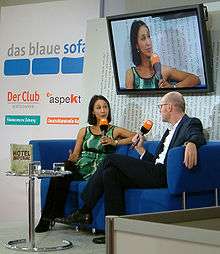Monica Ali
| Monica Ali | |
|---|---|
|
Ali in February 2011 | |
| Born |
20 October 1967 Dhaka, East Pakistan (now Bangladesh) |
| Occupation | Writer, novelist |
| Nationality | British |
| Ethnicity | Bengali-English |
| Education | Philosophy, Politics and Economics |
| Alma mater |
Wadham College University of Oxford |
| Spouse | Simon Torrance |
| Children | 2 |
Monica Ali (born 20 October 1967) is a Bangladeshi-born British writer and novelist. In 2003, she was selected as one of the "Best of Young British Novelists" by Granta magazine based on her unpublished manuscript; her debut novel, Brick Lane, was published later that year. It was shortlisted for the Man Booker Prize. It was adapted as a 2007 film of the same name. She has also published three other novels.
Early life and education
Ali was born in Dhaka, East Pakistan (now Bangladesh) in 1967 to a Bangladeshi father and English mother.[1] When she was three, her family moved to Bolton, England.[2] Her father is originally from the district of Mymensingh.[3] She went to Bolton School and then studied Philosophy, Politics and Economics at Wadham College, Oxford.
Brick Lane
Brick Lane – named after Brick Lane, a street at the heart of London's Bangladeshi community – follows the life of Nazneen, a Bangladeshi woman who moves to London at the age of 18, to marry an older man, Chanu. They live in Tower Hamlets. At first her English consists only of "sorry" and "thank you;" the novel explores her life and adaptations in the community, as well as the character of Chanu, and their larger ethnic community. An additional narrative strand covers the experiences of Nazneen's sister, Hasina through the device of her correspondence.[2]
Reception

The Observer described Chanu as "one of the novel's foremost miracles: twice her age, with a face like a frog, a tendency to quote Hume and the boundless doomed optimism of the self-improvement junkie, he is both exasperating and, to the reader at least, enormously loveable."[4] Geraldine Bedell wrote in The Observer that the "most vivid image of the marriage is of her [Nazneen] cutting her husband's corns, a task she seems required to perform with dreadful regularity. [Her husband] is pompous and kindly, full of plans, none of which ever come to fruition, and then of resentment at Ignorant Types who don't promote him or understand his quotations from Shakespeare or his Open University race, ethnicity and class module."[5]
The novel was well received by critics in the United Kingdom and the United States, and shortlisted for the Man Booker Prize.
However the novel provoked controversy within the Bangladeshi community in Britain. Some groups thought Ali had negatively portrayed people from the Sylhet region, as they constitute the majority of the Bangladeshi immigrants living in the Brick Lane community.
Film adaptation
In 2007, the book was adapted as a film of the same name. Starring the Indian actress Tannishtha Chatterjee, the film was distributed both in the UK and internationally.
When production was underway in 2006, some of the Bangladeshi community opposed Ruby Films' intention to film parts of the novel in the Brick Lane area. They formed the "Campaign Against Monica Ali's Film Brick Lane".
The writer and activist Germaine Greer expressed support for the campaign, writing in The Guardian:
"As British people know little and care less about the Bangladeshi people in their midst, their first appearance as characters in an English novel had the force of a defining caricature ... [S]ome of the Sylhetis of Brick Lane did not recognise themselves. Bengali Muslims smart under an Islamic prejudice that they are irreligious and disorderly, the impure among the pure, and here was a proto-Bengali writer with a Muslim name, portraying them as all of that and more."[6]
Greer criticised Monica Ali's "lack of authenticity", as she had never spent much time in the Brick Lane community, and no longer spoke the Bengali language fluently. The writer Salman Rushdie criticised Greer for getting involved, saying that her statements were "philistine, sanctimonious, and disgraceful, but ... not unexpected."[6]
Views
Ali opposed the British government's attempt to introduce the Racial and Religious Hatred Act 2006. She discussed this in her contribution to Free Expression Is No Offence, a collection of essays published by Penguin in 2005.
Ali is an opponent of the political development of "hurt feelings industry", a system of laws and legal practices in Southern Asia, mainly India, which enables religious groups and organizations to feel "hurt" by some texts or pieces of art, with the latter ones subsequently banned. Ali coined the term of "marketplace for outrage" describing the commercialization of these practices.[7]
Marks & Spencer's campaign
In 2013, Ali was announced as one of several new models for Marks & Spencer's 'Womanism' campaign. Subtitled "Britain's leading ladies", the campaign saw Ali appear alongside British women from various fields, including pop singer Ellie Goulding, double Olympic gold medal winning boxer Nicola Adams, and actress Helen Mirren.[8]
Personal life
Ali lives in South London[1] with her husband, Simon Torrance, a management consultant. They have two children, Felix (born 1999) and Shumi (born 2001).
Books
- Brick Lane (2003), Doubleday
- Alentejo Blue (2006), Doubleday
- In The Kitchen (2009), Doubleday
- Untold Story (2011), Scribner
See also
- British Bangladeshi
- List of British Bangladeshis
- List of English writers
- Bangladeshi writing in English
References
- 1 2 "Interview: Monica Ali, author". The Scotsman. 8 April 2011.
- 1 2 "Monica Ali — Biography", Literature, British Council.
- ↑ Gupta, Suman; Tope Omoniyi (2007). The Cultures of Economic Migration. Ashgate Publishing. p. 33. ISBN 978-0-8122-4146-4.
- ↑ Lane, Harriet (1 June 2003). "Ali's in Wonderland". The Observer. Retrieved 31 May 2005.
- ↑ Bedell, Geraldine (15 June 2003). "Full of East End promise". The Observer. Retrieved 31 May 2005.
- 1 2 Lewis, Paul (29 July 2006). "'You sanctimonious philistine' – Rushdie v Greer, the sequel". The Guardian. Retrieved 29 July 2006.
- ↑ Padmanabhan, Mukund (9 February 2012). "The Republic of Hurt Sentiments". The Hindu. Retrieved 24 July 2016.
- ↑ "Marks & Spencer's new ad: what does it mean?". The Guardian. 6 October 2016.
Further reading
- Bentley, Nick (2008), "Monica Ali, Brick Lane", in Bentley, Nick, Contemporary British fiction, Edinburgh, UK: Edinburgh University Press, pp. 83–93, ISBN 9780748624201.
- Benwell, Bethan; Procter, James; Robinson, Gemma (Winter 2011). "Not reading Brick Lane". New Formations: A Journal of Culture, Theory & Politics. Lawrence & Wishart. 73: 64–90. doi:10.3898/NEWF.73.06.2011. Pdf.
External links
- Official website
- Monica Ali on Twitter

- Monica Ali at British Council: Literature
- Monica Ali at the Internet Book List
- Brick Lane’s reluctant queen of outrage. Sunday Times. 18 November 2007
- Biography from the international literature festival berlin
- Interview with Monica Ali at Minnesota Public Radio
- Sanchita Ali considers the novel 'Brick Lane' on the London Fictions website
